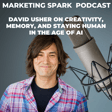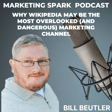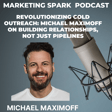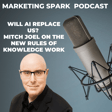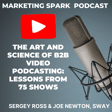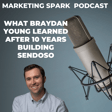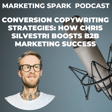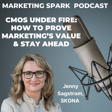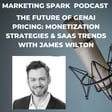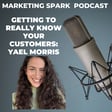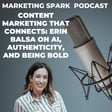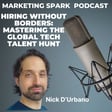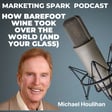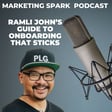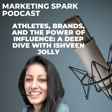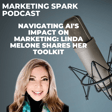Become a Creator today!Start creating today - Share your story with the world!
Start for free
00:00:00
00:00:01

The Power of Copy and Conversions in B2B SaaS Marketing
Words are powerful. They make as much an impact as video, photos, and audio.
But words and writing are often under-appreciated, particularly by people who aren't writers or marketers.
In this episode of the Marketing Spark podcast, Sam Howard talks about why words matter and best practices for using them to drive Website conversions.
Sam embraces a research-driven copywriting approach involving interviews with employees, customers and a competitive audit.
We talk about:
- Whether copy or design should come first when developing a Website
- Best practices for copy and structure of homepages
- Three killers tips for Website conversions
- How to create better CTAs, demo pages, and About pages.
Transcript
The Frustration of Unmet Expectations
00:00:07
Speaker
In football, there's pain when a team moves the ball to the one yard line, but can't punch it in for a touchdown. A lot of work and effort doesn't lead to success. It's frustrating and disappointing.
Why Marketing Efforts Fail to Convert
00:00:22
Speaker
In the B2B SaaS world, marketing is disappointing when it attracts and engages prospects, but can't get them to convert into customers.
00:00:32
Speaker
And there are many reasons why this happens. Maybe the product fails to live up to expectations. Maybe the positioning and messaging aren't as compelling as the competition. And maybe marketing and sales copy isn't enticing, interesting, or effective.
Sam Howard's Research-Driven Copywriting
00:00:50
Speaker
Well, to learn more about how to create copy that converts, I'm talking to Sam Howard, a conversion copywriter and strategist for B2B SaaS startups. Sam uses a research driven approach to create conversion copy without getting in the way of a company's marketing and initiatives. Welcome to Marketing Spark. Thank you. How did I do in describing what you do?
00:01:14
Speaker
As long as research-driven is in there, it's
Is Copywriting Undervalued?
00:01:17
Speaker
all good. Let's start by talking about whether copy gets the respect that it deserves. In many ways, I think of copy sort of being the Roddy Dangerfield of comedy. You can't get no respect. Now, as wordsmiths, we understand the value of words that make an impact. Is copy underappreciated in a world dominated by videos, photos, and GIFs?
00:01:43
Speaker
This may be just because I live in my little happy conversion copy bubble, but I think it does actually. The reason is that one does not simply convert a prospect with a GIF. There has to be some copy around it. In my experience, when prospects come to me, they realize they need help with copy and they're quite ready to
00:02:13
Speaker
give it the respect it so richly deserves. I'm very happy to hear that because often I think that words and copy are tremendously undervalued and underappreciated. For people who don't appreciate the value of copy, how do you get them to change their attitudes? In your experience, what's the approach or the best approach to make people understand why copy matters?
Measuring Copy's Impact on Conversions
00:02:40
Speaker
Well, once they start measuring what's going on with their email copy and their website copy and their ad funnels, then there's no work to be done on my end. Because in my experience, the moment startup folks realize that something is broken, they want to fix it. And in many cases, they realize that what's broken is copy.
00:03:08
Speaker
Now, whether or not that leads us to the actual research driven conversion copy process, that's a different question. I'll get into that. But one question I didn't want to ask you is when you're working with clients and even if they recognize the value of copy, is there an aha moment when they realize that copy is powerful and copy is doing what it needs to do to drive their business forward?
Voice of Customer in Effective Copy
00:03:34
Speaker
I would say that like perhaps the biggest aha moment I see is going from we're brainstorming our copy internally. And this is what we think we should put on our website too. This is voice of customer driven copy. This is what your existing customers and prospects say about you. And this is how we explain what your product does in their words. And in many cases, it's
00:04:01
Speaker
this shift from, we were trying to say this, but we didn't know how to, well, finally, now it's there on the page. They see the correlation between the words and success, and that's all the proof they need to embrace the power of copy. Yeah. I mean, we get to validation and conversion and all of that, but in many cases, the first aha comes when I present the copy and it's this final realization that this is exactly what we wanted to say.
Research: The Key to Effective Copy
00:04:30
Speaker
We just didn't know how.
00:04:31
Speaker
Right, right. I love it when that happens and the light bulbs go on and they do the happy dance when it comes to anything related to marketing. I wanted to talk about research driven copy. Now, a lot of people, including myself, are guilty of writing copy based on educated guesses. We've done this before. We've written a lot of copy and we think we have the
00:04:56
Speaker
insight and expertise to write copy that converts and often what happens is the copy doesn't resonate because we're missing something and I Obviously in your case you believe that is research. So walk me through the research driven approach to copy What's involved? What do you have to do? How much time does it take and how do you know you've got enough? Insight to write copy that's gonna make an impact a lot of questions there, but I'm it's a fascinating topic
00:05:26
Speaker
Yes, it really is. And full disclosure, copy hackers fan, copy school grads. So my approach is based on what copy hackers teach. I think that the most important thing is that you mentioned assumptions. And to me, like the whole point of the research is to minimize the amount of assumptions we're making in the copy. I tend to be slightly research obsessed.
00:05:54
Speaker
So I tend to do too much. And sometimes it doesn't need to be super heavy, right? But the first step definitely should be documenting the assumptions and documenting the things that don't work. If you're starting from scratch, not much you can do there, but if you already have a website, then
00:06:18
Speaker
knowing what's broken helps figure out the next steps and the gaps that exist. Okay, so that makes sense, but provide some tactical insight. So I haven't done any research yet. I'm starting my copy journey. What you're suggesting is I look at my website and am I looking at pages
Analyzing Website Conversion Rates
00:06:42
Speaker
that
00:06:44
Speaker
sort of convert and pages that don't convert and that's where I start to draw my assumptions? Or is it more than that? Assuming that you even have conversions set up, which is not always the case. Yes. So start with Google Analytics and Hotjar. For example, you might be assuming that everybody is reading through your sales page or your product description page, but are they really?
00:07:12
Speaker
And if they're not, what's happening instead? You might think that lots of people end up going to your demo signup form, but are they really? And if not, what's preventing them from filling out the form? So there may be things that you expect, and there may be things that you didn't even realize were happening, like UX issues. And those are quick wins. So if you can fix that, just do it right now. That you may realize that
00:07:43
Speaker
There are things that are broken, but you don't know why. And then the next step is trying to figure out the why. Okay. Then for the first step, you've, you've made your assumptions and this, these are educated guesses. You've got some biases, obviously. Then what happens? What do you do next?
Validating Assumptions with Team Insights
00:08:03
Speaker
I talk to product sales and customer success teams who will have their own biases, which is extra fun because then
00:08:10
Speaker
I get to kind of have this map of things that teams believe separately and things that everybody believes about their customers. And then I can go out and try and validate those assumptions and see how it all comes together in terms of website updates.
00:08:31
Speaker
So let's take a step back because you're skipping over a really important step. What are the questions that you're asking product, sales, and marketing? What kind of insight are you looking for? And what are the signs that either they're aligned or more troubling, they're misaligned when it comes to how they view the product and the value that it delivers?
00:08:55
Speaker
So many answers. So many questions. Let's start with the questions that you'll ask, the basic questions that you might ask across the board from marketing, sales, and product, and for customer success, for that matter. So I think that the most interesting one is the kind of overlap of sales and customer success, because sales talks to prospects, customer success supports folks who convert. So
00:09:21
Speaker
If they have totally different answers to who the best prospects and customers are, this is a big, well, it's not a really big problem. It's manageable, but it's a red flag for me. It means that something is broken along the way. And the same goes for, for example, for sales teams, assumptions about
00:09:43
Speaker
who will stay, who's the best prospect when they realize that they have a problem and what's the problem they're trying to solve. Because as a rule, they don't follow up on that. And then customer success can tell me about this end piece. And especially importantly, who turns out and who stays. When you've got that insight, and then as you mentioned, you want to validate it, what do you do? Do you go talk to customers directly? Do you do external research?
00:10:13
Speaker
using social media, what are, what is next steps in this journey?
Evaluating Competitors Before Customer Interaction
00:10:17
Speaker
Well, one of the things that I want to do before I talk to the customers is understand the competitive landscape because I cannot think of a case when a product did not have any competitors, direct or indirect. So I need to understand the differences and like why them in the first place. And after that, um,
00:10:41
Speaker
There are different ways to go about this. My preference, of course, is to talk to the customers, mostly because it helps me ask follow-up questions. Customers are humans. Humans are not always direct and or truthful, or sometimes they just need a little more prompting to get to the answer. So it's nice to be able to ask those questions.
00:11:07
Speaker
Let's take a step back in terms of doing competitive audit. Like I do it when I do positioning and messaging work. And I want to see how other companies talk about themselves. Can you walk me through how.
00:11:20
Speaker
what you do to identify what the competitors are saying and the copy that they're using. So is it on their websites? Are you looking at their blog posts, their eBooks, their videos? Like how deep do you go into a competitor's ecosystem to truly understand their approach to copy? No, I do not dig into their content unless we're optimizing for that stage of awareness. What I tend to look at is
00:11:49
Speaker
high level messaging, what is their homepage saying? Like if I only look at the hero section homepage, homepage hero section, what am I going to find out about them? And how different is it? And I would say at least seven times out of 10 websites can be shockingly similar. So knowing that
00:12:17
Speaker
Everybody is using the same words to describe their product and the solution and the problem is helpful. It means those words go on the please do not use that list. Great. Excellent insight. Before we get into copy in the wild, I wanted to talk a little bit more about conversions.
00:12:39
Speaker
Many startups and for that matter, companies want to hack their way into conversions. They're looking for shortcuts. We live in an instant gratification world and they want things to happen like right away. And for us marketers, sometimes it's very painful because marketing often takes time to resonate.
Hacks vs. Best Practices in Marketing
00:12:56
Speaker
Here's a little question. What are some of the best practices regarding conversions and the creative ways to drive them from your work with clients?
00:13:07
Speaker
I tend to get strong feelings around hacks. So let's talk about best practices instead. Okay. Best practices are great. Frameworks are great. The problem is that when folks are looking for best practices, in many cases, they're actually looking for hacks. They just want somebody to tell them to have like a red button instead of a green button or something like that, which to me is a hack or
00:13:37
Speaker
like rely on the fear of missing out to make your prospects convert. And yes, it could work, but again, totally outside of context, it's a hack that can backfire. Best practices will not backfire, but they are not, again, they're not 100%.
00:14:03
Speaker
going to work because it will depend on your audience. It will depend on your product. So what are best practices? Give me your top three best practices when it comes to copy that convert. One is actually most of them are related to user experience. Strangely enough, like do not force your visitors to do things.
00:14:27
Speaker
unless you have a very good reason to do so and it doesn't feel like you are taking away their autonomy. It goes beyond friction, right? Yes, demo forms and the friction of too many fields is a problem. If some of them are listed as not required, that already makes me feel better because I don't feel like I'm forced to give you all of this information. Another one is being very mindful of the layout.
00:14:56
Speaker
which technically not copy, but it's very relevant because we need to be mindful of how information is presented from not having blocks of text that are just unscannable to having visuals that contribute to the page instead of just taking up space. And the last one would be, again, more on the design side.
00:15:27
Speaker
not creating false bottoms. It's my favorite thing to hate on websites. What are false bottoms? It's like there's the section that looks like it's the start of the footer. So if your CTA is below that section, nobody is going to even see it. Right. Because everybody will assume that the page is complete.
00:15:49
Speaker
Let's turn our attention to copy in the wild and discuss some best practices and mistakes made by startups and larger companies. And obviously copy plays a huge role on websites. What are the biggest mistakes made by companies when it comes to website copy? Loaded question again, but maybe you can put the spotlight on some of the biggest mistakes that they make. Oh, I think the fluffy copy is the worst. Like especially hero sections with
00:16:19
Speaker
the fancy but meaningless two word headlines. And I think it's easier for larger companies to get away with this because let's be real. Probably everybody knows what MailChimp does. They don't need to explain it. But then startups go to the best examples of B2B SAS hero sections, swipe file, they realize that almost everybody has those
00:16:50
Speaker
tiny little headlines, they copy them and then the bounce rate goes up immediately. So that's my favorite thing to rant about. Okay. One of the things that I did want to ask you about is how do companies approach
00:17:11
Speaker
words on a page, the things that we like to create versus the business decisions that go into a website. Cause obviously at the end of the day, you can have a beautifully designed website. You can have wonderfully written copy, but if it doesn't drive the business forward, then it's all irrelevant.
Aligning Copy with Business Strategies
00:17:29
Speaker
So what's the balancing act and how should companies think about how to emphasize words and, and making the business move forward? I mean, it's hard.
00:17:42
Speaker
That's just how it is. And mostly it's hard because the business changes. The goals may not change, but the way you try to reach them may change. And so when this happens, very often there's this gap of several months between the change in strategy and the, oh, the website is not working anymore. Right.
00:18:07
Speaker
So the only thing that I can think of is being very deliberate about building in feedback loops and staying on top of website updates. It would be nice to think that your website can be this once done, done forever marketing task, but embracing the changes, the only way that I can think of that helps keep the web copy and the
00:18:37
Speaker
business strategy aligned. I mean, both are fluid. Both are dynamic. They, they're constantly evolving and they're written in sand, you know, not etched in stone. So I think that's really great advice. Obviously a lot of prospects and customers begin their digital journey with a company on the homepage. And what's your advice when it comes to homepage structure? It's troubling.
00:19:00
Speaker
puzzling to see so many homepages that have no logic behind them on how their homepages are structured and designed. It strikes me, this is probably an area that you spend a lot of time scratching your head about, given that it's so important in terms of making homepages convert or websites convert for that matter. I think I sort of understand why this happens. And it mostly happens because homepages are hard to get right when you don't know enough about your ICPs.
00:19:32
Speaker
and their stage of awareness. So if you're starting with, we just need to put something on the homepage, then yes, it will be a mess and it will make no sense at all. The way to work around this is either relying on the frameworks to guide you through the layout. And after that, you still need to figure out what to put in those sections, of course, or start with the research that will tell you what belongs on the homepage.
00:20:03
Speaker
which is my preferred way. One of the problems with homepages, at least in my opinion, is that companies cram in benefits, features, and use cases. It's like going on a first date and telling the person across the table everything about you.
00:20:23
Speaker
You know, your life story in one shot, it's a little overwhelming. How do companies put the spotlight on benefits, features, and use cases without overwhelming people? What's your advice in terms of making that journey and that presentation elegant and user friendly? I would, especially for the homepage, I would suggest figuring out the commonalities between the use cases or the ICPs.
00:20:50
Speaker
What is this one thing that they all need? And how can you show that your product is relevant for them? After that, you can give them some choices. If they need to find out more about a specific use case, great. They can do that at a specific use case page. But on the homepage, it doesn't need to be busy.
00:21:21
Speaker
You need to provide the necessary amount of information to help them continue working their way through the website to find information they need.
00:21:33
Speaker
So in a sense, I don't want to call the homepage a tease, but it does give them a taste of what's possible and the kind of content that they can engage in. And then the copy can do its work on subsequent pages. So essentially what you're saying is, it's a good place to start your journey, but don't try to tell people too much too soon. Like a lot of that is, it depends on the traffic, the ACPs, the jumps to be done. But essentially, yes, this is like a map.
00:22:03
Speaker
and it's up to the prospects to decide where they want to go next. Without inciting a words versus design battle, and as wordsmiths, we're very biased. What's your take on the value of website design, and what's the flow between copy design and conversions? I do not recommend doing design first. Okay. All right. Line of the sand right there. Why not?
00:22:32
Speaker
Design first will make it look good, but it will end up being extra work for the design team and for everybody involved in the process, unless the design team nails the copywriting argument from the get-go, which would be a very unreasonable expectation, I think. So when I work on projects, I start with wireframes.
00:23:00
Speaker
and I hand them over to the design team because it makes everyone's life easier. I know that the copy layout corresponds to what the prospects need to see and the design team does not need to go through weird Word documents and try to figure out what I mean.
00:23:21
Speaker
I like that approach. And in terms of wireframes, what does that consist of? Like how much detail are you providing in a wireframe? Is it generalized blocks of images here, content here, or is it a little more detailed than that? So for the copy, it has the visual hierarchy. So H1, H2, H3, buttons are definitely there. And ideal case scenario, which is what I tried to do.
00:23:49
Speaker
is to have a page that looks like a page minus images, which are placeholders. So it doesn't look finished. It's not supposed to look finished, but it shows what the copy needs to look like. And then the design team can play with all the beautiful visual elements that they have at their disposal.
00:24:12
Speaker
Sounds like a great approach. Let's do a mini rapid fire round. I'm going to ask you some short questions and you can answer for as long or as short as you want. CTAs, how do you make them appealing and drive curiosity rather than asking a simple question like, get a demo?
Enhancing CTAs: Beyond Button Text
00:24:31
Speaker
No questions, please. OK. Yeah, I don't think that CDA should ever be a demo. And ready to find out more is definitely not a CDA section headline I would ever recommend. With Curiosity, though, it can be appropriate for top of funnel content or even maybe pages. But I would try to be snappier and basically get out of the prospect's way once we are
00:25:01
Speaker
approaching a conversion. What's a better CTA than get a demo? It's not about the button copy. Well, it can be about the button copy, but it can also be about everything that surrounds the button copy. Are you addressing the objections that your prospects have? Are you explaining what's going to happen next? When are you going to get back to them? Are they going to be able to schedule a demo or
00:25:29
Speaker
Do they need to sit and wait for an email from your team? So all of that is more important than, in my opinion, all of that is more important than getting the button copy text just right. Demo forms, how do you make them more interesting and compelling? And who's the demo form for, sales or customers?
Making Demo Forms Engaging
00:25:51
Speaker
You would think it's for customers, but very often it is determined by what the sales team needs to know.
00:25:58
Speaker
In the cases when it is absolutely impossible to reduce the number of form fields, then yes, I would argue then trying to make the demo form more fun could work. Mostly I think of fun and form when I think about quizzes. That could also be a good use case, especially if you can hide some of the fields and break them up.
00:26:23
Speaker
That said, I strongly suggest finding different ways to qualify your prospects that do not involve lengthy form required fields and generally making it hard to convert. About pages, do you think that most companies, are they an overlooked opportunity for companies to connect and tell their company's story?
Crafting 'About' Pages with Customer Focus
00:26:47
Speaker
Yes. Most importantly, connect the company's story to what the prospects care about.
00:26:53
Speaker
Thank you for putting the spotlight on copy and conversions. Last question, where can people learn more about you and what you do? I am on LinkedIn, probably way too much. Yeah, like everybody in our world. And I also have a website at ecaterinahoward.com.
00:27:14
Speaker
Thanks for appearing on the podcast and thanks for everyone for listening to another episode of Marketing Spark. If you enjoyed the conversation, leave a review, subscribe via Apple Podcasts or your favorite podcast app, and of course share via social media. To learn more about how I help B2B SaaS companies as a fractional CMO, strategic advisor, and positioning wizard, email mark at markevans.ca or connect with me on LinkedIn. I'll talk to you soon.
